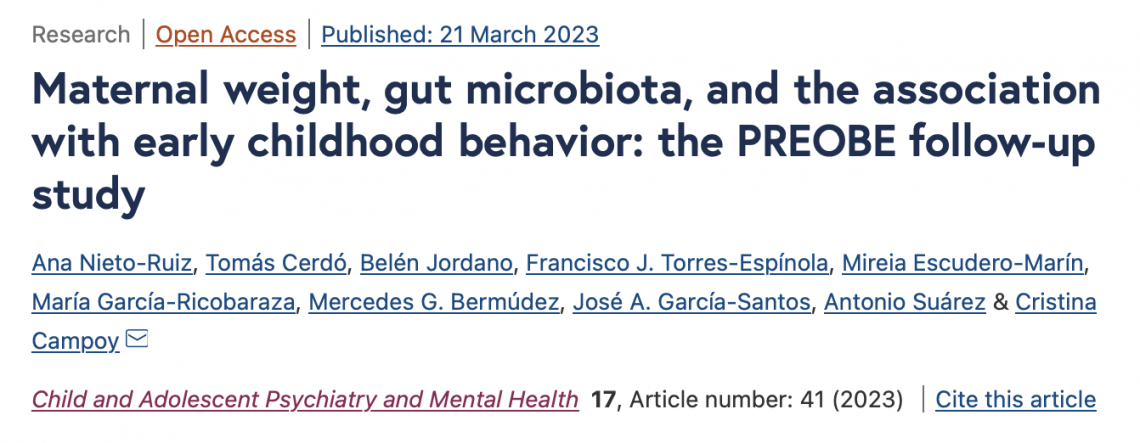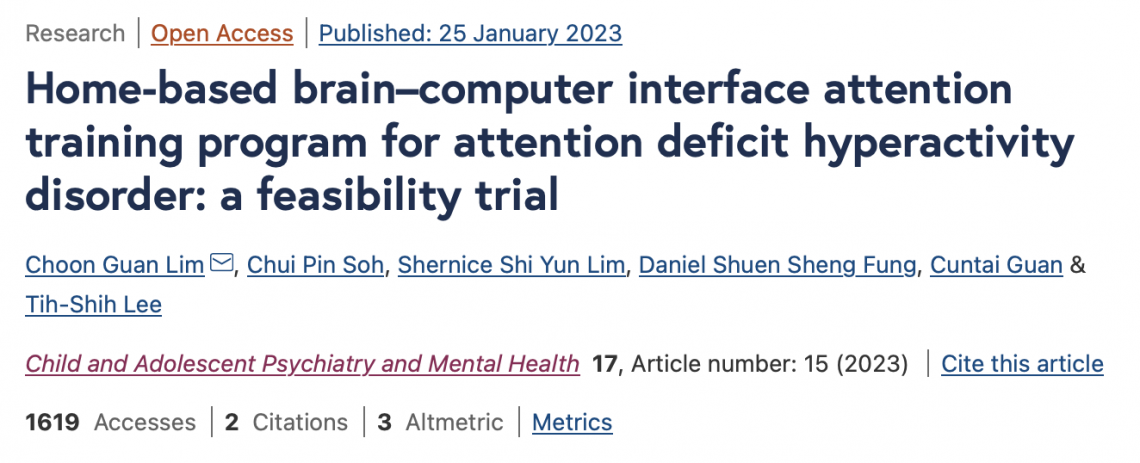CAPMH Corner (Updated Jun 2023)
By: Lakshmi Sravanti, India, Associate Editor, CAPMH
Child and Adolescent Psychiatry and Mental Health (CAPMH) is the official IACAPAP Journal. The "CAPMH Corner" of the Jun 2023 issue of IACAPAP Bulletin summarises the following three studies recently published in CAPMH – Maternal weight, gut microbiota, and the association with early childhood behavior: the PREOBE follow‑up study (Nieto‑Ruiz et al., 2023), Work‑family interface and children’s mental health: a systematic review (Bilodeau et al., 2023) and Home‑based brain–computer interface attention training program for attention deficit hyperactivity disorder: a feasibility trial (Lim et al., 2023).
Nieto‑Ruiz et al., (2023) discuss in detail the adverse influence of higher body mass index (BMI) and obesity in prepregnancy and pregnancy on maternal and fetal outcomes and child health and development especially in the first three years of life. They set out to evaluate the impact of preconceptional maternal BMI and/or gestational diabetes mellitus (GDM) on child behavior at 3.5 years old and study the possible influence of early gut microbiota composition and functionality and breastfeeding. It is a follow-up of the PREOBE study (Berglund et al., 2016).
The authors recruit 331 pregnant women aged 18 – 25 years between 2008 and 2012. They assign them to one of the three groups: 1. normoweight (18.5 ≤ BMI < 25), n = 71; 2. overweight (25 ≤ BMI < 30), n = 45; and 3. Obese (BMI ≥ 30, n = 40) based on their prepregnancy BMI. They collect baseline and background characteristics of the women and their offspring using questionnaires and medical records and an expert pediatrician interviews mothers at three months of age about infant diet, which was categorized as breastfeeding, formula feeding or mixed feeding. They extract genomic deoxyribonucleic acid (DNA) from the fecal bacteria of infants (n = 64) at 18 months of age. Parents complete the Child Behavior Checklist for Ages 1–5 (CBCL) (Spanish validated version) when their children are 3.5 years old. The team evaluates the differences in CBCL scores among the three PREOBE groups using an analysis of variance (ANOVA) or Kruskal‒Wallis rank-sum test for nonnormal continuous variables and a chi-square or Fisher’s test for categorical variables. They perform a univariate analysis of variance to determine differences according to the development of GDM.
The team reports that children born to overweight mothers showed higher scores in anxiety (p = 0.027) and total problems (p = 0.039) than children born to normoweight mothers, although significance was lost after adjustment for confounders (weight gain during pregnancy, maternal educational level and maternal IQ). Additionally, children born to obese mothers with GDM presented higher scores in aggressive behavior (p = 0.008) and oppositional defiant problems (p = 0.004) than the children born to obese mothers without GDM. They note that a higher maternal pregestational BMI was associated with higher anxiety (rs = 0.321; p = 0.003), internalizing (rs = 0.291; p = 0.006), externalizing (rs = 0.255; p = 0.018) and total problems (rs = 217; p = 0.045) in their children at 3.5 years old only in the group of children who were breastfed during their first 3 months of life. They also report that Fusicatenibacter abundance found at 18 months of age was associated to lower scores in total, internalizing and pervasive developmental problems, while an unidentified genus within Clostridiales and Flavonifractor families abundance showed a positive correlation with anxiety/depression and somatic complaints, respectively. They detect a positive correlation between Actinobacteria and somatic complaints, Fusobacteria and withdrawn behavior and Fusobacteria and pervasive developmental problems in their analysis of the gut microbiota composition of children at 18 months born to obese/overweight mothers who were exclusively breastfed during the first 3 months of life.
The authors mention the study’s longitudinal design as its significant strength that allowed for long-term monitoring. They acknowledge its limitations, such as the small sample size and the absence of data on the mother’s mental health status, stress, anxiety, depression, and other variables like diet or socioeconomic status. They conclude that maternal overweight/obesity, particularly with gestational diabetes, is linked to increased behavior problems in offspring and early gut microbiota, feeding practices, and maternal factors also play a significant role. They suggest further research to understand the underlying mechanisms.
Bilodeau et al., (2023) highlight the need to study the relationship between the work-family interface and the mental health of children of employed parents. They describe the two facets of the work-family interface: work-family conflict (WFC) and work-family enrichment (WFE) and hypothesize the mechanisms in which they can impact the mental health of children in the context of the pandemic.
The authors consider all studies published through June 2022 across 7 databases, including MEDLINE, Pub-Med, Web of Science, PsycINFO, SocIndex, Embase, and Scopus. Two authors of the study conduct an independent assessment of abstracts and titles by using COVIDENCE and select set of texts based on full reading. A third author resolves the conflicts in both phases. They identify 4,146 studies in their initial search, 25 of which met the inclusion and exclusion criteria. They assess quality of studies using a modified Newcastle–Ottawa scale and extract data using a predefined grid. They use I square (I2) statistic to evaluate the level of heterogeneity and synthesize data qualitatively to present the results narratively.
The team reports mixed evidence on links of WFC (n = 37) with adverse child psychological outcomes, with an equal number of positive associations (n = 18) and associations showing no effect (n = 18). They note a difference in the links of specific outcomes to work-family conflict, with a larger amount of associations showing adverse effects on internalizing behaviours (n=10; seven positive associations and three associations showing no effects) compared to externalizing behaviours (n=10; three positive associations and seven associations showing no effects). They suggest that the links to child mental health do not vary according to parental sex. Their data indicates that mediators such as parenting style or quality of relationship with the child (n=11) and parental mental health (n=3) have significant effects: for parenting characteristics, nine positive associations and two associations showing no effects; and for parental mental health, three positive associations. Their analysis of associations between work-family enrichment and child adverse psychological outcomes (n = 13) shows an opposite direction to work-family conflict, with no evidence of adverse effects (n = 0 for positive associations) and four negative associations (i.e. showing that work-family enrichment decreases child adverse psychological outcomes). Their results on WFE do not vary according to the type of outcome: externalizing or internalizing. They note that WFE among mothers than fathers seems to have a greater beneficial association with child mental health. Additionally, the team reports that parenting characteristics most often served as a potential mediator of WFE effects on child mental health.
The authors acknowledge the limitations of their study: low or intermediate quality of identified studies hindering result validity, and the inability to conduct a meta-analysis due to data heterogeneity. They also mention that due to limited studies on WFE it was difficult to assess its impact adequately. They conclude that the work-family interface impacts child mental health, both positively and negatively and suggest future studies to consider potential social and economic inequalities.
Lim et al., (2023) describe a brain–computer interface (BCI)-based attention training program to improve Attention deficit hyperactivity disorder (ADHD) symptoms. They conduct a single-centre, outcome-assessor blinded, parallel-group study (2019 to 2021) to test the feasibility and safety of delivering newly developed tablet-version of the BCI intervention at the child’s home without on-site support from any therapist.
The team recruits 20 children (6-12 years; 16 boys and 4 girls) diagnosed with ADHD. The participants undergo 24 BCI training sessions over a period of 8 weeks. They do not receive any psychosocial treatment or behavioural intervention while on the trial, and none of them had a history of receiving brain–computer interface or neurofeedback intervention. The research team randomly assigns to either the clinic-based group or the home-based group. A study administrator briefs and guides parents through the set-up procedure at the baseline visit (week 1) and team members follow-up via phone calls on week 3, 5 and 7 to check on the progress of the home-based program. The team programmed the game software such that the homebased group received the same amount of training per week as those in the clinic-based group. They administer ADHD Rating Scale and Child Behaviour Checklist (CBCL) at baseline (week 1) and post-intervention (week 8) to assess for treatment outcomes. The clinician rates the child based on the Children’s Global Assessment Scale (CGAS) and the Clinical Global Impressions Scale (CGI) during teleconsultations. They use non-parametric tests (two-tailed and at a 5% level of significance) to analyse the data.
The authors report that all participants except one completed the minimum of 20 BCI sessions within 8 weeks and two participants (10%), one from each treatment group, could not complete all 24 sessions owing to scheduling difficulties. They note that the participant from the home-based group missed 13 sessions (54%) despite periodic reminder calls to the parent and the participant from the clinic-based group missed 4 sessions (17%) as the parent had difficulties finding a person to accompany the child to the clinic due to work commitments. They report that two parents (20%) from the home-based group experienced some difficulties with setting up the game tablet and headset, however none of the children reported the same issue. In addition, 80% of the parents found that their child could undergo the BCI training with little to no supervision. They note that two (10%) participants reported experiencing an adverse event after completing the sessions – one indicated feeling mildly fatigued after playing the game, another reported that the child’s pre-existing vocal tics were more frequent on days that the game was played. The team records that the mean change (improvement) of inattentive symptom scores on clinician-rated and parent-rated ADHD-RS, were not significantly different between home-based [Mchange = 3.2 (clinician-rated); Mchange = 3.0 (parent-rated)] and clinic-based [Mchange = 3.9 (clinician-rated); Mchange = 1.8 (parent-rated)] groups.
The authors conclude that the tablet-based BCI attention training program can be safely delivered at home, providing an additional treatment option for ADHD without straining clinic resources and benefiting preschool-aged children. They allude to limitations of the small pilot trial: participants were likely more motivated and had milder ADHD symptoms, lack of blinding, inadequate power to evaluate clinical efficacy, absence of control for past interventions and reliance on reminder calls. The team suggests further clinical trials to establish therapeutic efficacy of BCI-based interventions, compare it with placebo and also explore its applications for other psychiatric and neurodevelopmental conditions.
REFERENCES:
- Berglund SK, Garc.a-Vald.s L, Torres-Espinola FJ, Segura MT, Martínez-Zaldívar C, Aguilar MJ, et al. Maternal, fetal and perinatal alterations associated with obesity, overweight and gestational diabetes: an observational cohort study (PREOBE). BMC Public Health. 2016;16:207. https:// doi.org/10.1186/s12889-016-2809-3.
- Bilodeau, J., Mikutra-Cencora, M. & Quesnel-Vallée, A. Work-family interface and children's mental health: a systematic review. Child Adolesc Psychiatry Ment Health 17, 45 (2023). https://doi.org/10.1186/s13034-023-00596-w
- Nieto-Ruiz, A., Cerdó, T., Jordano, B. et al. Maternal weight, gut microbiota, and the association with early childhood behavior: the PREOBE follow-up study. Child Adolesc Psychiatry Ment Health 17, 41 (2023). https://doi.org/10.1186/s13034-023-00589-9
- Lim, C.G., Soh, C.P., Lim, S.S.Y. et al. Home-based brain–computer interface attention training program for attention deficit hyperactivity disorder: a feasibility trial. Child Adolesc Psychiatry Ment Health 17, 15 (2023). https://doi.org/10.1186/s13034-022-00539-x




